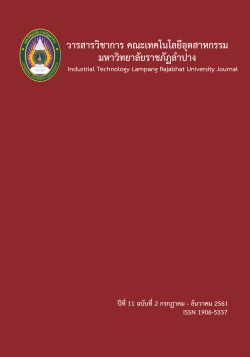Reinforcing Steel Cutting Methods to Minimize Trim Loss Steel for Precast Concrete L-Shape Retaining Wall
Keywords:
Minimize steel trim loss, L-shape retaining wall, Precast concreteAbstract
The objective of this research is to identify the optimum reinforcing steel cutting methods that would minimize trim losses in the production of precast concrete L-shape retaining wall with the dimension of 0.15 m. thick, 1.20 m. in width, 1.40 m. in height and 1.00 m. in length. Each retaining wall contains 22 rods of 0.95 m. RB 6 mm., 5 rods of 2.50 m. RB 6 mm. round bar and 5 rods of 2.70 m. DB 10 mm. deformed bar.
From the study of retaining wall production between 1 - 200 pieces, researchers have formulated a mathematical formula using integer linear programming models. There are one model for round bar RB 6 mm. 10 m. standard length and one model for deformed bar DB 10 mm. both 10 m. and 12 m. standard length. The researchers found that there are two cutting patterns needed for cutting RB 6 mm. round bar with a standard length of 10 m. into the required length of 0.95 m. and 2.50 m. resulting in 3.29% trim losses. However, there is only one cutting pattern required for cutting DB 10 mm. deformed bar with a standard length of 12 m. resulting in 11.11% trim losses. To obtain the minimum trim losses, the number of units in each production must be in the incremental of 20 (20, 40, 60, 80, 100, 120, 140, 160, 180 and 200 pieces).
Researchers provided a manual on steel rod cutting methods, which minimize trim losses steel for precast concrete L-shape retaining wall, and sent to the manufacturer in order to reduce waste in the factory. The manufacturer has utilized it to procure raw materials and executing production plan. The result shown less trim losses compare to previous trim loss management practice.
References
Gilmore, P.C. & Gomory, R.E. (1961). A linear programming approach to the cutting-stock problem. Operations Research, 9(6), 849-859.
Jahromi, M.H., Tavakkoli-Moghaddam, R., Makui, A., & Shamsi, A. (2012). Solving an one dimensional cutting stock problem by simulated annealing and tabu search. Journal of Industrial Engineering International, 8(24), 1-8.
Kantorovich, L.V. (1960). Mathematical methods of organizing and planning production. Retrieved January 12, 2018, from https://pubsonline.informs.org/doi/abs/10.1287/mnsc.6.4.366
Schrijver, A., (2000). Theory of Linear and Integer Programming. New York: John Wiley & Sons Ltd.
Solidiance. (2017). Thailand’s construction market is now driven by public infrastructure. Retrieved January 5, 2018, from https://www.thailand-business-news.com/real-estate/55961-thailands-construction-market-now-driven-public-infrastructure.html
Taylor III, B.W. (2013). Introduction to management science (11th ed). New Jersey: Pearson.
Vogt, F., (2015). Residential construction academy: Carpentry (4th ed). New York: HBI Building careers.
Wikipedia. (2018). Francois Coignet. Retrieved January 12, 2018, from https://en.wikipedia.org/wiki/ Fran%C3%A7ois_Coignet






